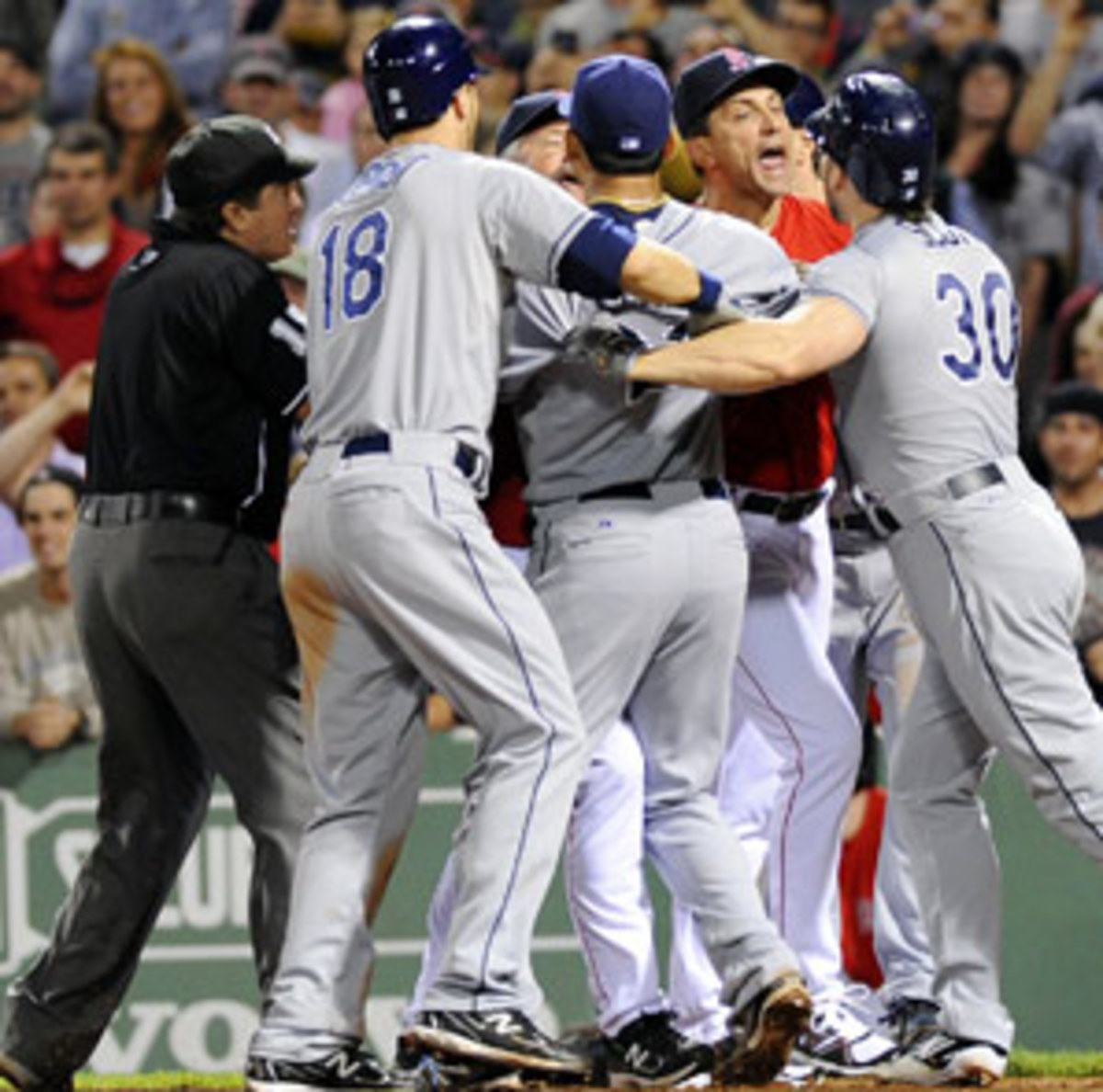
A guide to sports fighting terms
The non-fight last week between the Rays and Red Sox was called a "bench-clearing brawl" in headlines and highlight reels, when in fact it was just 50 people milling about the infield, the two sides barely even interacting, in the grand tradition of freshman mixers and wedding receptions.
This imprecision of language happens all the time in sports fights, which are frequently described in inverse proportion to their seriousness, so that a harmless tussle is a "bench-clearing brawl" while a forearm to the teeth is a "love tap."
It can be confusing. As a wrestling referee vainly attempts to restore calm during a cage match, so we ought to at least try to impose order on the chaotic language of sports fights, defining their escalation from least to most serious, as in Homeland Security's old color-coded terror chart.
What we need is a brief taxonomy, suitable for lamination. It would tell us definitively that the lowest level of sports fight is what foreign tabloids call "argy-bargy." This is a verbal dispute that may or may not lead to "handbags," a blanket term for the innocuous pushing and shoving seen in European soccer, as if two old ladies were swinging their handbags at one another. See also "handbags at 20 paces," which sometimes leads to a "dustup."
A dustup becomes a "punch-up" after two or more players square off, put up their dukes and "drop the gloves," one of hockey's many contributions to the sports-fight lexicon. We now have a "set-to." If the fighters' teammates are to do any "bench-clearing," this would be a good time, for once a punch is thrown the set-to has escalated -- depending on the sport and nation, and the gravity of the punches thrown -- to a "ruckus," "rumpus," "skirmish" or "scrap." A scrap, with no e, is marginally worse than a "scrape," with one. At the very least, we now have a bit of a "brouhaha."
In fights overseas, incidentally, the phrase "a bit" is meant as an intensifier, so that "a bit of aggro" -- in, say, Australian rules football -- will be worse than unadorned aggro. Aggro, in this case, refers to aggressive or violent behavior, covering the entire spectrum of sports fighting. A bit of aggro is, in my limited understanding, not as bad in Australia as a bit of "biffo," but then Australia has as many words for fighting as the Inuit have for puncturing the myth that they have a lot of words for snow.
But back to our sports fight. The aforementioned punch-up ushers in the official start of what are often called "fisticuffs," a word -- like scissors or underpants -- that only exists as a plural, so that both parties had better be throwing punches before anyone utters the f-word. When only one party is punching, he is throwing a "haymaker" (swinging freely as if scything down hay) or possibly "starting the lawnmower" (if his opponent is still on the ground). None of this is meant to condone or glorify fighting, any more than Webster intended to glorify aardvarks, quidnuncs or zoysias. Rather, it's an effort to cut through sport's many euphemisms -- like a scissors through underpants -- and arrive at a common understanding.
So then: Assuming that several others combatants have now joined the "fray" (or "fracas"), this fight has become a bona fide "bench-clearer." At this point, announcers are likely to call it a "melée," a French word meaning "baseball fight". (In fact, it means confused fighting, skirmishing or scuffling, which is what most baseball fights consist of.) But those announcers will be wrong. This is well beyond a melée. This is a full-scale "rhubarb" -- or even a "slobberknocker," in which participants, as the name suggests, endeavor to knock the slobber from one another.
As the principals in this rhubarb roll by in a cartoon cloud of stars and pound signs, fans of professional wrestling might recognize the fight as a "Pier-Six brawl," or "Pier-Sixer." Quite why Pier 6 is presumed to be tougher than all the other piers on the waterfront is a linguistic mystery. Suffice to say that the residents of Pier 6 long ago developed a reputation for wanton violence. (Indeed, their colleagues at Pier 1 still fear for the safety of their imported wicker furniture.)
A Pier-Sixer is total chaos. It's what is commonly called a "free-for-all" and less commonly -- but more poetically -- called a "foofaraw", which is how you say "free-for-all" with a mouthful of loose teeth.
A free-for-all, in turn, is sometimes referred to as "pandemonium" (from "Pandaemonium," the capital of Hell in Milton's Paradise Lost) or "bedlam" (an ancient corruption of the "Bethlehem" in London's Bethlehem psychiatric hospital).
For whatever reason, the very worst fights -- those at the top of our taxonomy --are named for places both real and imagined. The worst of these fights (though not of these places) is "donnybrook." For sheer pandemonium, nothing tops -- perhaps bottoms is a better verb -- a full-on donnybrook.
Donnybrook is now a prosperous suburb of Dublin, but was once the site of an annual fair renowned for violence and general mayhem. The Donnybrook Fair was banned more than 150 years ago, but lives on to this day whenever athletes get together for a bit of biffo, aggro, argy-bargy.
Or whatever you choose to call it.





